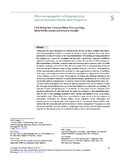Micro-propagation of Kappaphycus and Eucheuma: Trends and prospects
Share
Abstract
Among the red algae, Kappaphycus and Eucheuma are the two most commercially important carrageenophytes farmed extensively in Southeast Asian countries; they rank top in production in terms of volume of raw material produced. The farming of carrageenophytes has emerged as a successful enterprise and provides a promising, alternative livelihood option for low-income, coastal communities in a number of countries. In 2014, carrageenophyte production worldwide, surpassed other red seaweeds and was placed at the top of the production rankings with 10.99 million MT wet weight (77% of total production of farmed red seaweed) and Indonesia being a major producer. However, over time, the productivity of the crop (carrageenophytes) has declined in some regions due to sourcing of seedlings from single, selected genetic stocks considered to have higher yield potential which resulted in strain fatigue, or loss of vigour. The incidences of disease and epiphytic infestations are on rise in recent times which have severely affected biomass production, as well as the yield and product quality (carrageenan). In order to circumvent the crop productivity issues arising from clonal propagation, the raising of planting materials from spores, derived through the red algal sexual reproductive cycle, has been initiated to support the sustainability of selected, farmed carrageenophytes. Alternatively, in vitro tissue culture techniques have also been explored to not only rejuvenate the vigour of seedlings (i.e. the out-planting material) but also to seek seedlings resilient to stress, disease and epiphytes to act as an invigorated mother stock. These efforts have succeeded to a great extent in the development of appropriate techniques for explant culture, callus induction, callus sub-culture and regeneration to micro-propagules with improved traits. The present chapter briefly summarizes the developments and success achieved in micro-propagation of Kappaphycus and Eucheuma and also provides pointers to both gaps and priority areas for future research required for the advancement of sustainable farming of these carrageenophytes.
Suggested Citation
Reddy, C. R. K., Yokoya, N. S., Yong, W. T. L., Luhan, M. R. J., & Hurtado, A. Q. (2017). Micro-propagation of Kappaphycus and Eucheuma: Trends and prospects. In A. Q. Hurtado, A. T. Critchley, & I. C. Neish (Eds.), Tropical Seaweed Farming Trends, Problems and Opportunities (pp. 91-110).



